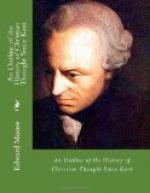In the earliest Christian writings the fruit of this reflexion lies before us in this form:—The Creator of worlds, the mediator, the lord of angels and demons, the Logos which was God and is our Saviour, was yet a humble son of man, undergoing suffering and death, having laid aside his divine glory. This picture is made with materials which the canonical writings themselves afford. Theological study had henceforth nothing to do but to avoid extremes and seek to make this image, which reflexion upon two polar opposites had yielded, as nearly thinkable as possible. It has been said that the trinitarian doctrine is not in the New Testament, that it was later elaborated by a different kind of mind. This is not true. But the inference is precisely the contrary of that which defenders of the dogma would formerly have drawn from this concession. The same kind of mind, or rather the same two kinds of mind, are at work in the New Testament. Both of the religious elements above suggested are in the Gospels and Epistles. The New Testament presents attempts at their combination. Either form may be found in the literature of the later age. If we ask ourselves, What is that in Jesus which gives us the sense of redemption, surely we should answer, It is his glad and confident resting in the love of God the Father. It is his courage, his faith in men, which becomes our faith in ourselves. It is his wonderful mingling of purity and love of righteousness with love of those who have sinned. You may find this in the ancient literature, as the Fathers describe that to which their souls cling. But this is not the point of view from which the dogma is organised. The Nicene Christology is not to be understood from this approach. The cry of a dying civilisation after power and light and life, the feeling that these might come to it, streaming down as it were, from above, as a physical, a mechanical, a magical deliverance, this is the frame within which is set what is here said of the help and redemption wrought by Christ. The resurrection and the incarnation are the points at which this streaming in of the divine light and power upon a darkened world is felt.
That religion seemed the highest, that interpretation of Christianity the truest, the absolute one, which could boast that it possessed the power of the Almighty through his physical union with men. He who contended that Jesus was God, contended therewith for a power which could come upon men and make them in some sense one with God. This is the view which has been almost exclusively held in the Greek Church. It is the view which has run under and through and around the other conception in the Roman and Protestant Churches. The sense that salvation is inward, moral, spiritual, has rarely indeed been absent from Christendom. It would be preposterous to allege that it had. Yet this sense has been overlaid and underrun and shot through with that other and disparate idea of salvation, as of a pure bestowment, something achieved




